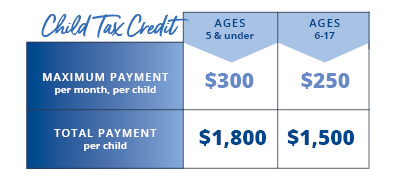Child Tax Credit 2021: What you need to know
Millions of American parents have begun to receive monthly payments from the government as part of a recently restructured child tax credit.
How is the tax credit changing?
Traditionally, the child tax credit has been available to apply as a credit against any federal taxes owed at the end of the year. The new rules allow qualifying families to receive some of the credit in the form of monthly payments, from July 2021 to December 2021, rather than a lump-sum credit at tax time.
Here's how it works: Taxpayers earning less than $75,000 (or married couples earning less than $150,000) can receive half of the child tax credit broken into six monthly payments for the last half of 2021. The full tax credit for each child age 5 and under is $3,600 per year, and $3,000 for each child between the ages of six and 17. To see how much you could receive, use the IRS eligibility assistant.

You can choose when to receive the credit
Taxpayers who meet the qualifications to receive the child tax credit will be automatically enrolled in the monthly payment program. And if the IRS has your direct deposit information, that is how you will receive the payment (similar to the stimulus payments from last year). However, if you prefer, you can opt out of receiving the monthly payments.
Why would you refuse the monthly cash payments? Some people might want to take the whole lump sum at tax time. Or, if your income is close to the limit, you may want to avoid the possibility of having to repay the monthly payments in case you don't qualify at the end of the year.
If you prefer to opt out, you can make those changes on the IRS website. But keep in mind that once you've opted out of monthly payments, you can't opt back in. You will, however, be able to take the credit when you file taxes in 2022, as long as you qualify.
Smart ways to use the funds
If you don't plan to opt out, think about ways to use tax credit payments strategically to make a positive impact on your finances and help move you forward toward your goals. Consider adding one or all five of these strategies to your plan.
1. College savings. A few hundred dollars each month over the next six months may not seem like it will make a difference when you're thinking about a huge expense like college. But if you continually contribute your tax credit payments to a 529 savings plan, depending on the interest rate the funds can grow significantly over the next 10 years.
2. Extracurricular activities. Raising kids is expensive, and that's the whole point of the child tax credit. It might make sense to use your payments to pay for your child's sports, music, art, or other extracurricular activities. This way, you can invest in your child's passions, and there's no impact on your family budget.
3. Build your emergency fund. If you have a robust emergency fund in place, you won't have to turn to credit cards or other debt when the unexpected arises. You may need to replace an appliance, cover a major car repair, or face another one of life's surprises. Use the child tax credit to create or add to your emergency fund, which will help you stay on track financially without being thrown off course by inevitable emergencies.
4. Pay down debt. Credit card debt and other consumer debt can keep you from reaching your financial goals. Rather than saving for the future, you may be spending a large portion of your monthly income keeping up with minimum debt payments. If you're burdened by debt, think about using your child tax credit funds to pay it down and help move your family to more solid financial ground.
5. Save for a future goal. Most families raising kids have lots of hopes and plans for their children. Maybe you dream of taking your family on a special trip or purchasing a car for your teen. Depositing the child tax credit payments into a savings account can help you get closer to that goal.
The monthly child tax credit payments can offer significant relief from financial pressures, but it also presents an ongoing opportunity. By being intentional with your payments, you can maximize their impact on your family finances now and well into the future.




